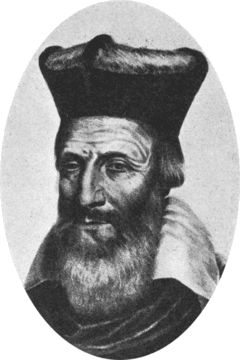Name Pierre de | ||
 | ||
Died November 17, 1632, Montpellier, France | ||
Pierre Richer de Belleval (1564 – November 17, 1632), was a French botanist. He is considered the father of scientific botany.
Richer de Belleval was born in Châlons-en-Champagne. His father was N. Richer or Richier. He first went to Montpellier to study medicine in 1584, but ended up receiving his MD from Avignon in 1587. In 1587, immediately after completing his M.D., Belleval married the daughter of a deceased seigneur de Prades (who had enriched himself by trade and purchased the estate) near Montpellier. There was a considerable dowry, and it is clear that this personal estate helped to support Belleval throughout his life.
Between 1587 and 1593 he practiced medicine in Avignon (and possibly Comtat) and then in Pezenas. His services towards the people of Pezenas during an epidemic disorder, brought him under the protection of the governor of Languedoc, Henri de Montmorency. Then, Henry IV of France appointed Belleval as his personal physician (although he remained in Montpellier and was not at the court). Belleval also served as a personal physician of Louis XIII of France. There are documented financial favors that he received from Henry.
In 1593 he was appointed to the new royal chair of anatomy and botanical studies of Montpellier. Two years later, in 1595, he received his doctorate in medicine in Montpellier. In 1593 Henry IV of France asked him to create a botanical garden in Montpellier following the model of the gardens created in Padoua in 1545. Belleval devoted all of his time and money to the Jardin des plantes de Montpellier, which was the first botanical garden in France. The garden contained the King's Garden (medicinal plants), the Queen's Garden (mountain plants from Languedoc and elsewhere) and the King's Square (plants of purely botanical interest). The goal was to have a garden for conducting experiments related to both medicine and agriculture. Unfortunately, a civil war and a siege of the city destroyed the garden in 1622 and Pierre Richer de Belleval had to recreate the garden from scratch and continued working on this until his death at Montpellier. His nephew accomplished the re-establishment of the garden on a more extensive scale.
Richer de Belleval published a catalog of the garden in 1598 and a French treatise in 1605, recommending an inquiry into the native plants of Languedoc. This last was accompanied by five plates, intended as a specimen of a future work, for which he subsequently prepared a number of engravings, rude and stiff in execution but exhibiting many rare species. He did not live to publish these and the plates remained neglected in the bands of his family. The plates were finally published much later, in 1796 after Gilibert obtained the plates. The pamphlets were republished in 1785 by Broussonet.
The genus Bellevalia Lapeyr., in the family Asparagaceae, is named in honour of him.
